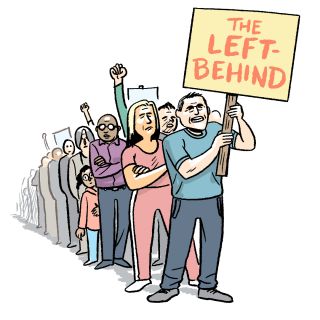The Unfair Legacy of Budget 2023 measures

Since February 2022, Government have announced a series of taxation, welfare and electricity credit measures intended to assist all households with cost of living pressures. Using the Social Justice Ireland Income Distribution model, we bring together the impact of all these changes, from February 2022 to those announced in February 2023 (including additional welfare payments scheduled up to July 2023). These capture: the household energy credits and lump sum increases in fuel allowances announced between February and April 2022 (2022 pre-Budget 2023 measures); the additional welfare payments and energy credit measures announced as part of Budget 2023 but for implementation before the end 2022 (Budget 2023 for 2022); the welfare, taxation and energy credit measures announced in Budget 2023 for implementation in 2023 (Budget 2023 for 2023); and the lump-sum welfare payments and one-off increases in the Back to School Clothing and Footwear allowance announced in February 2023, with payments running to July 2023.
The households we examine are those tracked annually in our income distribution model. They are spread across all areas of society and capture those with a job, families with children, those unemployed and pensioner households. Within those households that have income from a job, we include workers on the minimum wage, on the living wage, and PAYE earners on incomes ranging from €30,000 to €200,000. We present the results of this analysis in Table 1.
Table 1: Combined Weekly Impact of Cost of Living Measures plus Tax & Benefit Changes, Feb 2022-July 2023 (€ per week)
|
|
2022 pre-Budget 2023 measures |
Budget 2023 measures for 2022 |
Budget 2023 measures for 2023 |
February 2023 measures |
Total |
|
Welfare Dependent Households |
|
|
|
|
|
|
Couple, 2 children (both over 12yrs) |
3.84 |
16.77 |
31.87 |
15.37 |
67.85 |
|
Couple, 2 children (both under 12yrs) |
3.84 |
16.77 |
31.83 |
15.37 |
67.81 |
|
Couple pensioner |
8.17 |
20.76 |
30.65 |
7.69 |
67.27 |
|
Lone parent, 1 child (over 12yrs) |
15.86 |
11.44 |
21.83 |
7.69 |
56.81 |
|
Lone parent, 1 child (under 12yrs) |
15.86 |
11.28 |
21.81 |
7.69 |
56.64 |
|
Single pensioner |
8.17 |
20.66 |
19.77 |
3.85 |
52.45 |
|
Couple, no children |
3.84 |
10.49 |
27.75 |
7.69 |
49.77 |
|
Single unemployed |
3.84 |
7.83 |
19.77 |
3.85 |
35.29 |
|
|
|
|
|
|
|
|
Household with Jobs |
|
|
|
|
|
|
Couple 2 earners at €200,000 |
3.84 |
3.83 |
39.51 |
0.00 |
47.18 |
|
Couple 2 earners at €150,000 |
3.84 |
3.83 |
39.51 |
0.00 |
47.18 |
|
Couple 2 earners at €100,000 |
3.84 |
3.83 |
39.51 |
0.00 |
47.18 |
|
Couple 2 earners at €80,000 |
3.84 |
3.83 |
39.51 |
0.00 |
47.18 |
|
Single, job at minimum wage |
3.84 |
3.83 |
31.46 |
0.00 |
39.13 |
|
Couple 1 earners at €100,000 |
3.84 |
3.83 |
26.94 |
0.00 |
34.62 |
|
Couple 1 earner at €60,000 |
3.84 |
3.83 |
26.94 |
0.00 |
34.62 |
|
Single, job at €120,000 |
3.84 |
3.83 |
23.59 |
0.00 |
31.26 |
|
Single, job at €100,000 |
3.84 |
3.83 |
23.59 |
0.00 |
31.26 |
|
Single, job at €60,000 |
3.84 |
3.83 |
23.59 |
0.00 |
31.26 |
|
Single, job at €40,000 |
3.84 |
3.83 |
23.59 |
0.00 |
31.26 |
|
Couple 2 earner & 2 children, at €60,000 |
3.84 |
9.20 |
14.20 |
3.85 |
31.08 |
|
Couple 1 earner & 2 children, at €30,000 |
3.84 |
9.20 |
8.45 |
3.85 |
25.33 |
|
Couple 2 earners at €60,000 |
3.84 |
3.83 |
14.20 |
0.00 |
21.87 |
|
Single, 1 child, job at €30,000 |
3.84 |
3.83 |
11.32 |
1.92 |
20.92 |
|
Single, job at living wage |
3.84 |
3.83 |
11.32 |
0.00 |
19.00 |
|
Single, job at €30,000 |
3.84 |
3.83 |
11.32 |
0.00 |
19.00 |
|
Couple 1 earner at €30,000 |
3.84 |
3.83 |
8.45 |
0.00 |
16.12 |
Overall, the weekly impact on the households examined is large, ranging from €67.85 to €35.29 a week for welfare dependent households and from €47.18 to €16.12 a week for households with jobs. Within welfare dependent households the largest assistance has been received by those with children. Among working households tax changes have favoured those with income subject to the higher income tax rate.
However, there is a marked difference in the way that the cost of living measures have been delivered to households. They have included temporary measures, such as electricity credits and one-off additional welfare and fuel allowance payments, alongside permanent measures announced as part of Budget 2023 such as changes to the value of core welfare payments and changes to tax credits and bands.
To illustrate this, among single people in 2023, Budget 2023’s permanent changes to taxes and welfare delivered the following average weekly gains:
- An unemployed person: + €12.10
- An earner on €30,000: + €3.65
- An earner on €80,000: + €15.92
- An earner on €100,000: + €15.92
Among couples in 2023, the Budget’s permanent changes to taxes and welfare delivered the following average weekly gains:
- A pensioner couple: + €22.98
- An unemployed couple: + €20.08
- With 1 earner on €30,000: + €0.78
- With 1 earner on €60,000: + €19.27
- With 2 earners on €100,000: + €31.84.
Overall, Budget 2023’s legacy was to widen further the gap between the better off and those on the lowest welfare and work incomes. Given the challenges that so many households face in making ends meet, particularly those on the lowest incomes, much of this assistance was welcome and badly needed. Yet, in the absence of measures in Budget 2024 targeted at low income households, the legacy of recent cost of living measures will be to widen further the gap between the better off and those on the lowest welfare and work incomes. Budget 2024 needs to address this unwelcome distributive outcome and prioritise those on the lowest incomes in our society.
Budget Choices 2024 is available to download here.
